
An apricot is a fruit, or the tree that bears the fruit, of several species in the genus Prunus.

Canna or canna lily is the only genus of flowering plants in the family Cannaceae, consisting of 10 species. Cannas are not true lilies, but have been assigned by the APG II system of 2003 to the order Zingiberales in the monocot clade Commelinids, together with their closest relatives, the gingers, spiral gingers, bananas, arrowroots, heliconias, and birds of paradise.
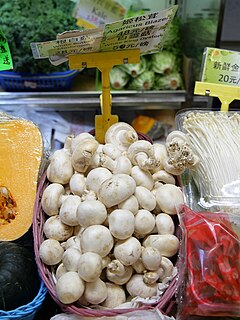
Edible mushrooms are the fleshy and edible fruit bodies of several species of macrofungi. They can appear either below ground (hypogeous) or above ground (epigeous) where they may be picked by hand. Edibility may be defined by criteria that include absence of poisonous effects on humans and desirable taste and aroma. Edible mushrooms are consumed for their nutritional and culinary value. Mushrooms, especially dried shiitake, are sources of umami flavor.
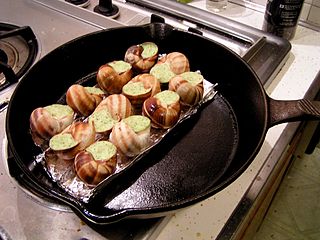
Escargot, from the French word for snail, is a dish consisting of cooked land snails. It is often served as an hors d'oeuvre and is common in France and parts of India. Escargot is part of the typical cuisines of Cyprus, Malta, Crete, areas of mainland Greece, as well as the North African countries Tunisia, Algeria, and Morocco. Escargot is consumed in Germany, Great Britain, Italy, Portugal, and Spain.

Enoki, also known as velvet shank, is a species of edible mushroom in the family Physalacriaceae. It is well known for its role in Japanese cuisine, where it is also known as enokitake.

Flammulina is a genus of fungi in the family Physalacriaceae. The genus, widespread in temperate regions, has been estimated to contain 10 species.
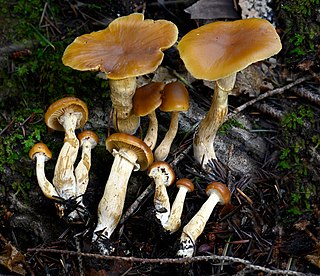
Galerina marginata, known colloquially as the funeral bell or the deadly skullcap, is a species of poisonous fungus in the family Hymenogastraceae of the order Agaricales. Prior to 2001, the species G. autumnalis, G. oregonensis, G. unicolor, and G. venenata were thought to be separate due to differences in habitat and the viscidity of their caps, but phylogenetic analysis showed that they are all the same species.

Partitiviridae is a family of double-stranded RNA viruses. Plants, fungi, and protozoa serve as natural hosts. The name comes from the Latin partitius, which means divided, and refers to the segmented genome of partitiviruses. There are five genera and 60 species in the family, 15 of which are unassigned to a genus.
Oligonucleotidase is an exoribonuclease derived from Flammulina velutipes. This enzyme catalyses the following chemical reaction

The Physalacriaceae are a family of fungi in the order Agaricales. Species in the family have a widespread distribution, ranging from the Arctic, (Rhizomarasmius), to the tropics, e.g. Gloiocephala, and from marine sites (Mycaureola) and fresh waters (Gloiocephala) to semiarid forests (Xerula).
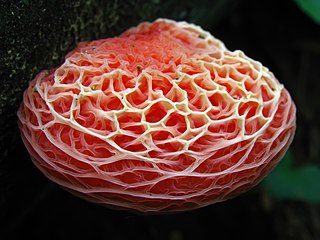
Rhodotus is a genus in the fungus family Physalacriaceae. It is a monotypic genus and consists of the single mushroom species Rhodotus palmatus, known in the vernacular as the netted rhodotus, the rosy veincap, or the wrinkled peach. This uncommon species has a circumboreal distribution, and has been collected in eastern North America, northern Africa, Europe, and Asia; declining populations in Europe have led to its appearance in over half of the European fungal Red Lists of threatened species. Typically found growing on the stumps and logs of rotting hardwoods, mature specimens may usually be identified by the pinkish color and the distinctive ridged and veined surface of their rubbery caps; variations in the color and quantity of light received during development lead to variations in the size, shape, and cap color of fruit bodies.

Hicksbeachia pinnatifolia is a small tree in the family Proteaceae. This rare species is native to subtropical rainforest in New South Wales and Queensland in Australia. Common names include red bopple nut, monkey nut, red nut, beef nut, rose nut and ivory silky oak. The tree produces fleshy, red fruits during spring and summer. These contain edible seeds.

Agaricus deserticola, commonly known as the gasteroid agaricus, is a species of fungus in the family Agaricaceae. Found only in southwestern and western North America, A. deserticola is adapted for growth in dry or semi-arid habitats. The fruit bodies are secotioid, meaning the spores are not forcibly discharged, and the cap does not fully expand. Unlike other Agaricus species, A. deserticola does not develop true gills, but rather a convoluted and networked system of spore-producing tissue called a gleba. When the partial veil breaks or pulls away from the stem or the cap splits radially, the blackish-brown gleba is exposed, which allows the spores to be dispersed.

Baccatin III is an isolate from the yew tree. Baccatin III is a precursor to the anti-cancer drug paclitaxel (Taxol).
Galactan endo-beta-1,3-galactanase is an enzyme with systematic name arabinogalactan 3-beta-D-galactanohydrolase. This enzyme catalyses the following chemical reaction
Medicinal fungi are fungi which contain metabolites or can be induced to produce metabolites through biotechnology to develop prescription drugs. Compounds successfully developed into drugs or under research include antibiotics, anti-cancer drugs, cholesterol and ergosterol synthesis inhibitors, psychotropic drugs, immunosuppressants and fungicides.

Flammulina populonica is an edible winter mushroom. It differs from closely related species Flammulina velutipes by being slightly larger in size and having a thicker stem. It grows on wood of quaking aspen and other poplars.
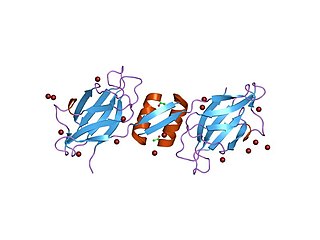
Fungal immunomodulatory proteins (FIPs) are a type of functional compound found in various species of fungi. FIPs are part of the immunoglobulin (ig) family, which are structurally similar to human antibodies, and can interact with human peripheral blood mononuclear cells (PBMCs), causing these cells to secrete different types of hormones and regulate cellular activity.














